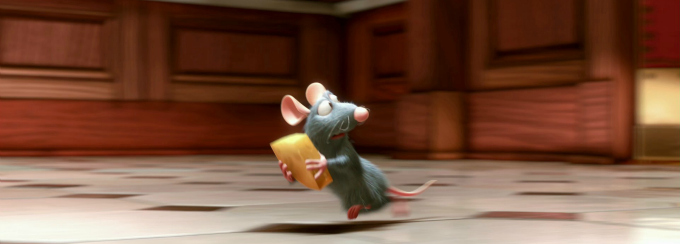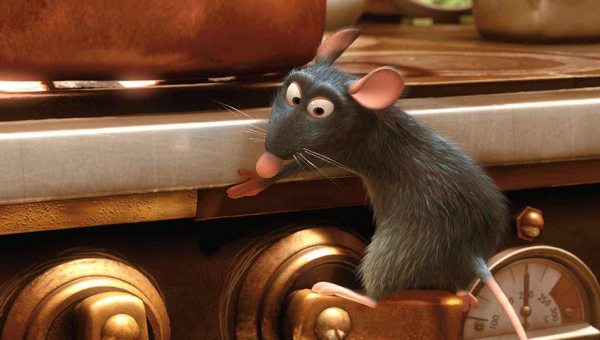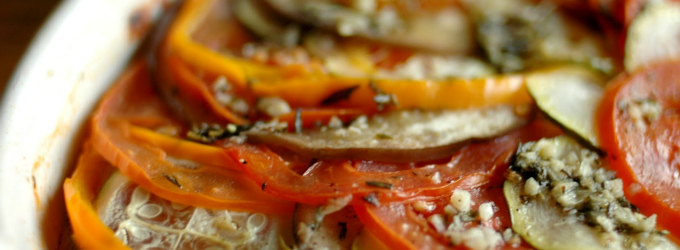 In 2007 RATATOUILLE made a financially record breaking debut in France, and the country was well represented at the recent Picturehouse screenings. Disney Pixar’s fifth highest grossing film enraptured its young audience, whose Franglais exclamations pealed out throughout the screening.
In 2007 RATATOUILLE made a financially record breaking debut in France, and the country was well represented at the recent Picturehouse screenings. Disney Pixar’s fifth highest grossing film enraptured its young audience, whose Franglais exclamations pealed out throughout the screening.
The story was conceived by Jan Pinkava using a simple driving conflict: a rat longs to be a gourmet cook, and yet he’s considered vermin by his would-be employers. This aspiring chef, Remy, is introduced in a scene which pays homage to the freeze-frames from Scorsese’s GOODFELLAS: Remy bursts through a cottage window, using a stolen recipe book as a makeshift parachute, and is captured mid-flight as the voiceover begins: “This is me.” (“Mouse!” hollered one excitable audience member). The determined young rat, voiced by comedian Patton Oswalt, forms a Cyrano de Bergerac style alliance with the clumsy plongeur Linguini (Lou Romano), who conceals the rat under his toque. Remy controls Linguini by tugging at his hair, which facilitates plenty of slapstick to offset a romantic, witty and dramatic storyline that is never cheap or condescending: RATATOUILLE caters for all tastes.
… the Pixar title sequence reminds us that they are able to make even a plain, featureless anglepoise lamp endearing …
Pinkava’s premise was developed by Brad Bird, who preserved the spirit of the original script whilst shifting the emphasis on key characters. In particular, Linguini’s love interest, the rôtisseur Colette Tatou (voiced by Janeane Garofalo) was fleshed out by Bird into a complex and compelling character reminiscent of La Gavroche’s terrifying sous-chef, Monica Galetti. As for the animal characters, unlike THE RESCUERS’ Miss Bianca the rodents of RATATOUILLE trot on all fours – apart from the hygiene conscious Remy, who walks on his hind legs to keep his front paws clean. “If Dad sees you walking like that, he’s not gonna like it,” warns Remy’s brother Emile. The rats are anthropomorphised, but with an artistic licence that is more Pixar than Disney: the Pixar title sequence reminds us that they are able to make even a plain, featureless anglepoise lamp endearing. Therefore, the rats’ gypsy camp is furnished with found objects rather than miniatures, and although the rats speak, they don’t wear clothes or behave in a way that is completely humanised – their culture has a well-researched basis in real rat lifestyle and behaviour.
… one of the animators plunged into a swimming pool wearing full chef gear, so that his wet apron could be studied …
Several innovations mark RATATOUILLE out as new territory for Disney Pixar. For instance, it’s shot in hyper-real and immersive detail from two perspectives: man and rat. The illumination and movement of a tablecloth from a diner’s point of view have been painstakingly designed; and where we see the same cloth from a rat’s point of view, its warp and weft are magnified into a coarse terrain. To help create a convincing look for Linguini after his fall into the Seine, one of the animators plunged into a swimming pool wearing full chef gear, so that his wet apron could be studied. Although the human characters are stylistically rendered, the attention to detail is astounding – from the cuts and burns on the chefs’ hands to their authentic cooking techniques, and the patina on the pans they wield. A second innovation is the portrayal of food. Not only were the animators sent on crash courses in high end restaurants, but a way of conjuring the smell and taste synaesthetically was conceived by Michel Gagné, who used music and abstract imagery in the style of Oscar “Fantasia” Fischinger to suggest the flavour combinations Remy describes so rhapsodically.
…the essence of romantic Paris: no skyscrapers, tourists or crottes de chien.
If you enjoy Disney Pixar, their films will always bear repeat viewings – as most toddlers will agree. Alongside child-friendly adventure and old-school comedy, RATATOUILLE offers us the essence of romantic Paris: no skyscrapers, tourists or crottes de chien. RATATOUILLE is a jubilant celebration of the French, of rats, of food, of romance and above all, it shows a deep and honest love of animated storytelling.
Peter O’Toole’s character, the food critic Anton Ego, rounds off the film with a review which bears repeating for the benefit of all critics:
In many ways, the work of a critic is easy. We risk very little, yet enjoy a position over those who offer up their work and themselves to our judgement. We thrive on negative criticism, which is fun to write and to read. But the bitter truth we critics must face is that in the grand scheme of things, the average piece of junk is probably more meaningful than our criticism designating it so. But there are times when a critic truly risks something, and that is in the discovery and defence of the new. The world is often unkind to new talent and new creations. The new needs friends. […] Not everyone can become a great artist, but a great artist can come from anywhere.
httpvh://youtu.be/niD-jahFURU
We have cooked RATATOUILLE’s signature dish, which was based on Thomas Keller’s confit byaldi. We can assure our readers that it is a simple but sublime take on the Provençal classic. The recipe can be found below and is easy to make. Anyone can cook!
FOR PIPERADE
1/2 each of a red, a yellow and an orange pepper, seeds and ribs removed
2 tb extra virgin olive oil
1 tsp minced garlic
1/2 cup finely diced Spanish onion
12 oz tomatoes, peeled, seeded, and finely diced, juices reserved
1 sprig thyme, 1 sprig flat-leaf parsley, 1/2 a bay leaf
Sea salt
FOR VEGETABLES
4-5 oz of each of the following:
Large courgette
Aubergine
Yellow squash
Beef tomato
1/2 tsp minced garlic
2 tsp olive oil
1/8 tsp thyme leaves
Sea salt and freshly ground black pepper
FOR VINAIGRETTE
1 tb extra virgin olive oil
1 tsp balsamic vinegar
Assorted fresh herbs (thyme flowers, chervil, thyme)
Sea salt and freshly ground black pepper
MAKING PIPERADE
Heat oven to 450 degrees. Place pepper halves on a foil-lined sheet, cut side down and roast until skin loosens (about 15 minutes). Remove from heat and let rest until cool enough to handle. Peel and chop finely.
Fry oil, garlic, and onion over low heat until very soft but not browned (about 8 minutes). Add tomatoes, their juices, thyme, parsley, and bay leaf. Simmer over low heat until very soft and very little liquid remains (about 10 minutes). Do not brown. Add peppers and simmer to soften them. Season to taste with salt, and discard herbs. Reserve tablespoon of mixture and spread remainder in bottom of an 8-inch baking dish.
ASSEMBLING VEGETABLES
Pre-heat oven to 275 degrees and slice courgette, aubergine, squash and tomato into 1/16 inch rounds using a chef’s knife or mandolin. Down centre of pan, arrange a strip of 8 alternating slices of vegetables over the piperade, overlapping so that 1/4 inch of each slice is exposed. Around the center strip, overlap vegetables in a close spiral that lets the slices mound slightly toward the centre. Repeat until the tray is filled; all vegetables may not be needed.
Mix garlic, oil, and thyme leaves in bowl and season with salt and pepper to taste. Sprinkle this dressing over the vegetables. Cover pan with foil and crimp edges to seal well. Bake until vegetables are tender (about 2 hours). Uncover and bake for 30 minutes more. (Lightly cover with foil if it starts to brown.) If there is excess liquid in pan, place over medium heat on stove until reduced.
(At this point it may be cooled, covered and refrigerated for up to 2 days. Serve cold or reheat in 350-degree oven until warm.)
VINAIGRETTE
Combine reserved piperade, oil, vinegar, herbs, and salt and pepper to taste in a bowl.
TO SERVE
Brown byaldi lightly under grill. Slice in quarters and very carefully lift onto plate with offset spatula. If you’ve got good sleight of hand, turn spatula 90 degrees, guiding byaldi into fan shape. Drizzle vinaigrette around plate. Serve hot.
Yield: 4 Michelin style starters – or two normal person’s starters.


